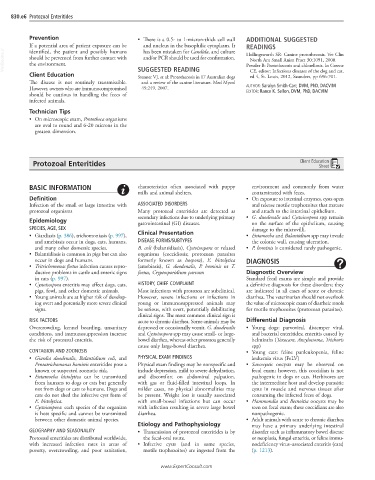Page 1653 - Cote clinical veterinary advisor dogs and cats 4th
P. 1653
830.e6 Protozoal Enteritides
Prevention • There is a 0.5- to 1-micron-thick cell wall ADDITIONAL SUGGESTED
If a potential area of patient exposure can be and nucleus in the basophilic cytoplasm. It READINGS
VetBooks.ir should be prevented from further contact with and/or PCR should be used for confirmation. Hollingsworth SR: Canine protothecosis. Vet Clin
has been mistaken for Candida, and culture
identified, the patient and possibly humans
North Am Small Anim Pract 30:1091, 2000.
the environment.
Pressler B: Protothecosis and chlorellosis. In Greene
Client Education SUGGESTED READING CE, editor: Infectious diseases of the dog and cat,
ed 4, St. Louis, 2012, Saunders, pp 696-701.
Stenner VJ, et al: Protothecosis in 17 Australian dogs
The disease is not routinely transmissible. and a review of the canine literature. Med Mycol
However, owners who are immunocompromised 45:249, 2007. AUTHOR: Saralyn Smith-Carr, DVM, PhD, DACVIM
EDITOR: Rance K. Sellon, DVM, PhD, DACVIM
should be cautious in handling the feces of
infected animals.
Technician Tips
• On microscopic exam, Prototheca organisms
are oval to round and 6-20 microns in the
greatest dimension.
Protozoal Enteritides Client Education
Sheet
BASIC INFORMATION characteristics often associated with puppy environment and commonly from water
mills and animal shelters. contaminated with feces.
Definition • On exposure to intestinal enzymes, cysts open
Infection of the small or large intestine with ASSOCIATED DISORDERS and release motile trophozoites that mature
protozoal organisms Many protozoal enteritides are detected as and attach to the intestinal epithelium.
secondary infections due to underlying primary • G. duodenalis and Cystoisospora spp remain
Epidemiology gastrointestinal (GI) diseases. on the surface of the epithelium, causing
SPECIES, AGE, SEX damage to the microvilli.
• Giardiasis (p. 386), trichomoniasis (p. 997), Clinical Presentation • Entamoeba and Balantidium spp may invade
and amebiasis occur in dogs, cats, humans, DISEASE FORMS/SUBTYPES the colonic wall, causing ulceration.
and many other domestic species. B. coli (balantidiasis), Cystoisospora or related • P. hominis is considered rarely pathogenic.
• Balantidiasis is common in pigs but can also organisms (coccidiosis; protozoan parasites
occur in dogs and humans. formerly known as Isospora), E. histolytica DIAGNOSIS
• Tritrichomonas foetus infection causes repro- (amebiasis), G. duodenalis, P. hominis or T.
ductive problems in cattle and enteric signs foetus, Cryptosporidium parvum Diagnostic Overview
in cats (p. 997). Standard fecal exams are simple and provide
• Cystoisospora enteritis may affect dogs, cats, HISTORY, CHIEF COMPLAINT a definitive diagnosis for these disorders; they
pigs, fowl, and other domestic animals. Most infections with protozoa are subclinical. are indicated in all cases of acute or chronic
• Young animals are at higher risk of develop- However, severe infections or infections in diarrhea. The veterinarian should not overlook
ing overt and potentially more severe clinical young or immunosuppressed animals may the value of microscopic exam of diarrheic stools
signs. be serious, with overt, potentially debilitating for motile trophozoites (protozoan parasites).
clinical signs. The most common clinical sign is
RISK FACTORS acute to chronic diarrhea. Some animals may be Differential Diagnosis
Overcrowding, kennel boarding, unsanitary depressed or occasionally vomit. G. duodenalis • Young dogs: parvoviral, distemper viral,
conditions, and immunosuppression increase and Cystoisospora spp may cause small- or large- and bacterial enteritides; enteritis caused by
the risk of protozoal enteritis. bowel diarrhea, whereas other protozoa generally helminths (Toxocara, Ancylostoma, Trichuris
cause only large-bowel diarrhea. spp)
CONTAGION AND ZOONOSIS • Young cats: feline panleukopenia, feline
• Giardia duodenalis, Balantidium coli, and PHYSICAL EXAM FINDINGS leukemia virus (FeLV)
Pentatrichomonas hominis enteritides pose a Physical exam findings may be nonspecific and • Sarcocystis oocysts may be observed on
known or suspected zoonotic risk. include depression, mild to severe dehydration, fecal exam; however, this coccidian is not
• Entamoeba histolytica can be transmitted and discomfort on abdominal palpation, pathogenic in dogs or cats. Herbivores are
from humans to dogs or cats but generally with gas or fluid-filled intestinal loops. In the intermediate host and develop parasitic
not from dogs or cats to humans. Dogs and milder cases, no physical abnormalities may cysts in muscle and nervous tissues after
cats do not shed the infective cyst form of be present. Weight loss is usually associated consuming the infected feces of dogs.
E. histolytica. with small-bowel infections but can occur • Hammondia and Besnoitia oocysts may be
• Cystoisospora: each species of the organism with infection resulting in severe large bowel seen on fecal exam; these coccidians are also
is host specific and cannot be transmitted diarrhea. nonpathogenic.
between other domestic animal species. • Adult animals with acute to chronic diarrhea
Etiology and Pathophysiology may have a primary underlying intestinal
GEOGRAPHY AND SEASONALITY • Transmission of protozoal enteritides is by disorder such as inflammatory bowel disease
Protozoal enteritides are distributed worldwide, the fecal-oral route. or neoplasia, fungal enteritis, or feline immu-
with increased infection rates in areas of • Infective cysts (and in some species, nodeficiency virus–associated enteritis (cats)
poverty, overcrowding, and poor sanitation, motile trophozoites) are ingested from the (p. 1213).
www.ExpertConsult.com

